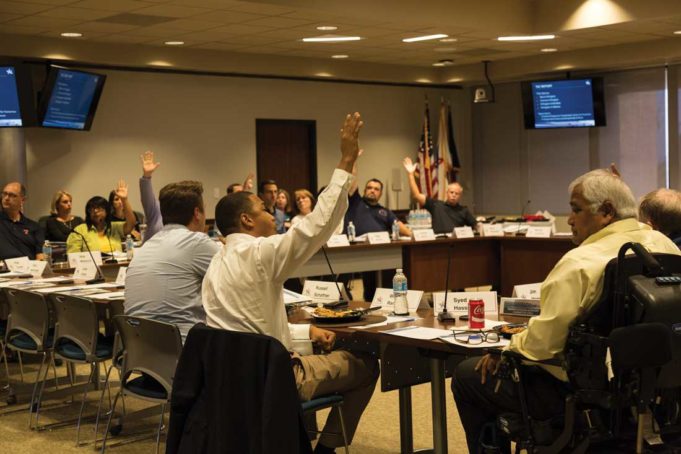Before moving to Arlington two years ago, Shima Hamidi lived car-free in Salt Lake City, where she worked for the University of Utah. The area’s public transportation system took her anywhere she wanted to go in the Greater Salt Lake Area. In addition to buses, there were FrontRunner commuter trains and the light rail system, TRAX. Hamidi did not have to make room in her budget for car payments, liability insurance, gasoline, car maintenance and repairs, or annual inspections and vehicle registrations.
But all that changed when Hamidi accepted a job at the University of Texas at Arlington. Although at first she hoped that she might be able to continue her carefree car-free lifestyle, she was crushed to discover during her first visit to Arlington before starting her new job that there was simply no way. Now Hamidi’s 2015 white Honda Accord is among hundreds of thousands of other vehicles clogging Arlington’s – and the rest of North Texas’ – thoroughfares every day.
“Anywhere you want to go – the grocery store, the pharmacy – there’s no other option,” she said. “You have to drive.”
As an assistant professor of planning in UTA’s College of Architecture, Planning and Public Affairs (CAPPA), Hamidi is fortunate to be able to afford a vehicle. But a large number of students who live in university housing aren’t so lucky, she said. They must rely on friends to take them grocery shopping and on other necessary errands.
“They are students,” Hamidi said. “They have limited income and they have to pay tuition.”
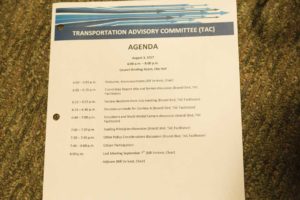 Some current and former Arlington residents blame the city’s lack of mass transit on former city leaders who they claim feared that public transportation would draw a bad element, causing the city’s crime rate to rise. (Hamidi and others interviewed for this story said they have heard that tale.) But it was actually Arlington’s citizens who voted down public transportation, and they did so three times – in 1980, 1985, and 2002, according to city spokesperson Jay Warren.
Some current and former Arlington residents blame the city’s lack of mass transit on former city leaders who they claim feared that public transportation would draw a bad element, causing the city’s crime rate to rise. (Hamidi and others interviewed for this story said they have heard that tale.) But it was actually Arlington’s citizens who voted down public transportation, and they did so three times – in 1980, 1985, and 2002, according to city spokesperson Jay Warren.
The county, not the city, spearheaded the 1980 election, Warren said. The question put before voters by the city in August of 1985 and May of 2002 was for the creation of the Arlington Transit Authority, to be paid for through a sales tax. In 1985, it was not to exceed one-half of one percent. In 2002, it was one-quarter of one percent.
But voters said no.
Arlington is now the largest city in the United States without mass transit. Inching ever closer to 400,000 in population, the Tarrant County town between Fort Worth and Dallas has more people than Cincinnati, Cleveland, Honolulu, New Orleans, Pittsburgh, Tampa, and several other, older cities.
Arlington has only the Entertainment District’s trolley and two automated shuttles, the UTA shuttle, the Handitran ride share service for the elderly and disabled, and Metro ArlingtonXpress (MAX), which runs Monday through Friday and takes riders to specific destinations in Arlington, Dallas, and Fort Worth, including DFW International Airport.
It is likely, though, that in the not-too-distant future, the city’s residents will once again vote on whether to bring mass transit to Arlington.
On Tuesday, Sept. 26, the mayor’s 31-member Transportation Advisory Committee, created a year ago, will present its recommendations during the regular City Council meeting. Though some with a more cynical nature view previous failed attempts as a sign that the city will be forever gridlocked, Mayor Jeff Williams has a more positive outlook. There were, he said, “a lot of reasons” why public transportation initiatives failed in the past, and now there are many more options that weren’t available then.
“The solutions were very, very expensive,” Williams said, “and a lot of our voters were afraid it wouldn’t pay for itself. Now, that’s not the case. When we take a vote next time, it won’t include any of the things that were voted on then because we have new inventions. We won’t even be considering light rail or buses.”
It’s not, after all, the ’80s anymore.
“We’re not going to be voting on a rotary phone,” the mayor said. “It’s a new day.”
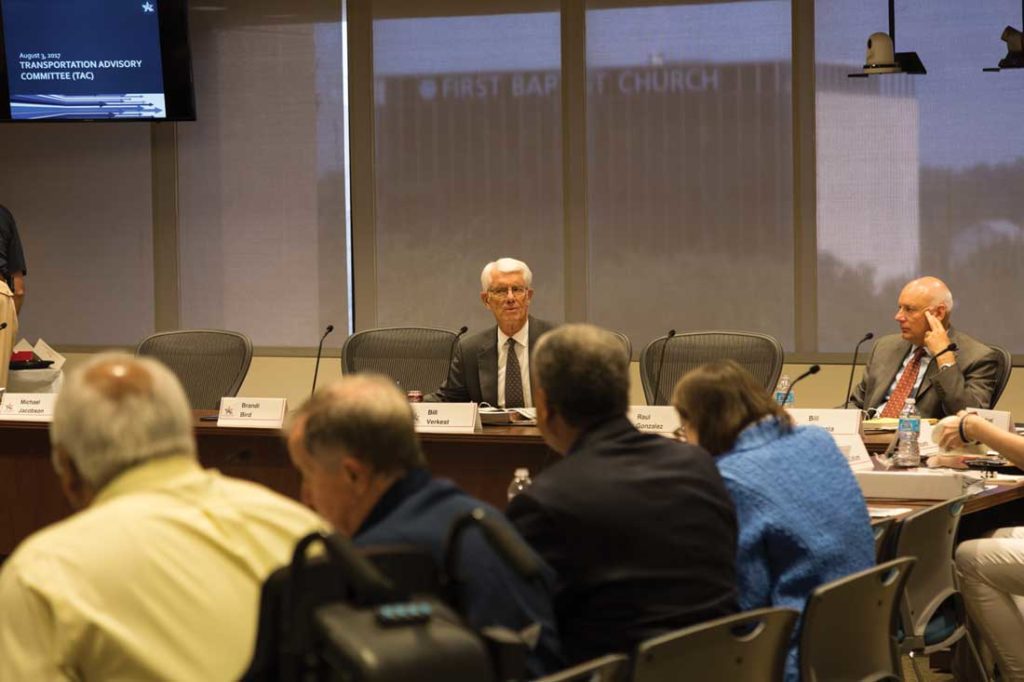
Citizen Involvement
On the sultry evening of Thursday, Aug. 3, as others were heading home at the end of the workday or sitting down to dinner, members of the Transportation Advisory Committee trudged up the steps of Arlington City Hall, rode elevators to the third floor, and took seats at tables arranged in an expansive square in the Council Briefing Room. On one side of the room were several rows of chairs, which were filled by media and the otherwise interested.
The first order of business was to vote on a title and tagline for the committee’s report. The winners were “Connect Arlington” and “A Transportation Vision Connecting People and Places.”
The committee has met for two hours one evening per month since last October. Tonight, they were in the home stretch, with just one more meeting to go before Committee Chair Bill Verkest would present the group’s recommendations to the mayor and City Council.
Verkest, who retired in 2011 after a 48-year career in public works, said that the committee has included “very influential” and “important” people representing a cross-section of the community.
“The [Texas] Rangers are represented, for example,” he said. “The chamber is represented, as are faith-based organizations. It’s a very broad-based and very diverse committee. In my mind, the committee has worked extremely well the past 11 months. Every meeting was productive.”
Meetings featured presentations with such titles as “Hubs, Corridors and Modes,” “Funding Opportunities,” “Transportation Modes and Best Practices,” “Near-Term Solutions,” and “City of Arlington: Existing and Future Conditions,” which included detailed maps showing population density, jobs density, and traffic patterns.
“One of the first things we did was identify public transportation options,” Verkest told the Fort Worth Weekly. “We looked at 16 different options. Technology is changing rapidly. Tesla came out a while back and said they were going to put drones in the air that can carry people by 2020, but I seriously doubt we will recommend to the City Council that they should put drones in the air. That’s too specific a mode of transportation. We might use broader language, such as a ‘personal transportation vehicle,’ which could very well include drones, but we’re not going to say ‘drones.’ ”
The committee does, however, favor on-demand ride share options such as Uber, Lyft, or Bridj.
“They pick you up at home and take you where you want to go,” Verkest said. “Chariot is another one that will pick up and drop off at given locations, but it’s not a door-to-door service. On-demand ride share is one of the options that is being considered by the committee. But is the total focus going to be on-demand ride share? I’m going to say it’s not.”
Although shuttle buses are part of the dialogue, a fleet of diesel buses is not –– and never will be, according to Verkest, other committee members, and the mayor.
“Most people believe that mass transit is buses,” Verkest said. “But I will tell you this, the committee, we will not recommend putting buses on the streets of the city of Arlington.”
Verkest said that one reason the committee isn’t interested in diesel buses is because voters have rejected that option three times. But there are other reasons as well.
“We don’t need any more carbon emissions going into the air, because our cars do enough of it,” he said.
A third strike against diesel buses is that the city’s streets cannot accommodate them without modifications. Plus, bus shelters would need to be built, Verkest said.
Mayor Williams said people aren’t even arguing about diesel buses anymore.
“That is outdated,” he said. “We have much better alternatives. I mean, Uber, Lyft, the automated vehicles –– all of them are much better alternatives.”
The Transportation Advisory Committee is proposing that any public transit plans focus on six particular corridors. The first connects the CentrePort and DFW International Airport Trinity Railway Express station to the Entertainment District. Corridor 2 runs along Cooper Street and connects the Entertainment District to South Arlington. The third corridor links the Entertainment District to the Southeast Campus of Tarrant County College, the fourth runs along I-30, the fifth along I-20, and the sixth along Pioneer Parkway.
The committee is proposing that the first and second corridors have four main hubs and that nine smaller hubs be scattered throughout the city.
The group favors circulatory transportation options that include shuttles and autonomous vehicles that it believes would work well for certain areas such as the Entertainment District. These modes of operation would function along a closed loop, traveling short distances and maintaining set schedules.
“The only thing highly specific is the corridors that we feel need to be served by public transportation,” Verkest said. “Beyond that, our recommendations are not going to be this type of transportation or this system. We won’t be saying there needs to be cable cars running up and down Cooper Street. It’s much broader than that.”
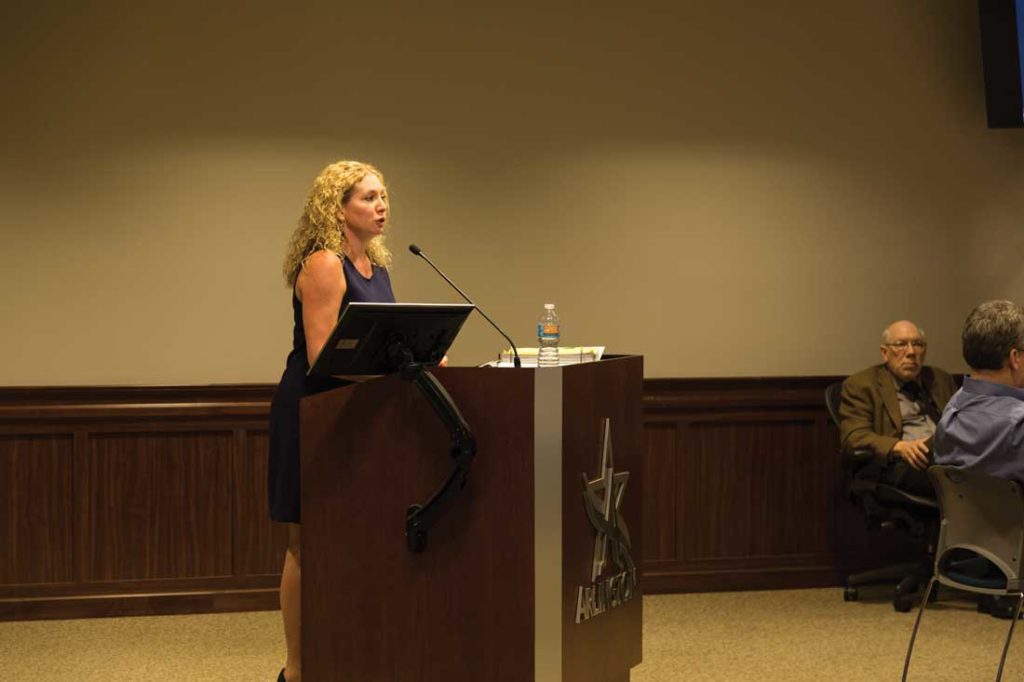
On the Move
If you knew nothing about Arlington and formed an opinion based solely on the city’s unassuming City Hall and the businesses around it on West Abram Street, that opinion would likely be wrong. The area gives no indication of the money that floods into the city’s 99 square miles simply because of entertainment. Most notable are the Dallas Cowboys’ AT&T Stadium, the Texas Rangers’ Globe Life Park, Six Flags Over Texas, Six Flags Hurricane Harbor, Meadowbrook Golf Course, and River Legacy Park.
Shopping, dining, and other types of entertainment abound: The Parks Mall at South Cooper Street and I-20, which features an ice skating rink and movie theater; The Arlington Highlands at I-20 and Matlock Road, which boasts a Studio Movie Grill, BJ’s Brewhouse, and The Improv Theatre; and Lincoln Square, by I-30 and North Collins near AT&T Stadium, which offers a smattering of casual dining restaurants and stores such as PetSmart and Michaels.
Arlington is also the world headquarters for bowling. Within its city limits is the International Bowling Campus, which houses the United States Bowling Congress, the International Bowling Museum, and the International Bowling Hall of Fame.
And then there’s Theatre Arlington, one of the largest community theatres in the nation.
Next year, the city will have even more ways for people to spend their disposable income. Texas Live!, near Globe Life Park, will open two years ahead of the Texas Rangers’ new $1 billion, retractable-roof stadium, providing 200,000 square feet of restaurants, retail, and entertainment. The mixed-use development will include Arlington Backyard, an outdoor events pavilion that will accommodate crowds of up to 5,000 for events ranging from concerts to art shows. About 250 events will be held there annually.
The city located 12 miles from downtown Fort Worth and 20 miles from downtown Dallas is well on its way to becoming a premier sports and entertainment destination, which is exactly what city leaders intend.
“Arlington,” Williams said, “is on the move.”
The city is also “pretty unique,” he noted.
“There is no other city in the world –– and I’m not exaggerating –– that has a major amusement park, major league baseball, a national football league team, and a major university,” the mayor said. “And you add to that, we are in the middle of the Metroplex, with downtown Fort Worth on one side, downtown Dallas on the other, and we are the gateway to DFW International Airport.”
The Dallas Business Journal recently tapped Arlington for the top spot in its latest list of high-dollar economic deals in North Texas. The city was ranked No. 2 for two consecutive years. The publication listed $1.55 billion worth of business deals in 2016.
“Our tourism has grown by 40 percent in the last five years,” Williams said. “UTA will grow to 50,000 students by 2020, according to the chancellor. Tarrant County College is helping to train the workforce. You wrap all that up, it gives us a chance to improve services for citizens while keeping the property tax rate down. Arlington’s is among the lowest in the region. That’s very exciting.”
On Saturday, Aug. 26, the city debuted “Milo,” two autonomous wheelchair-accessible shuttles that, as part of a pilot program, are providing free rides along off-streets in the Entertainment District during stadium and ballpark events. Although the 12-passenger shuttles can accelerate, brake, and steer on their own and have collision avoidance systems, a certified operator will always be onboard, city officials said.
Williams said there’s a good chance that the driverless vehicles, made by EasyMile of Toulouse, France, will eventually be used to transport students around the UTA campus.
“It’s amazing, the many different things that are being invented,” the mayor said, adding that he attended a transportation conference a couple of months ago where it was stated that new modes of transportation are being invented virtually every week.
“There are new solutions now to transportation, solutions that do not include light rail, which is very expensive, or diesel buses,” Williams said. “We’ve got much better alternatives to turn to. In fact, some of the solutions haven’t been invented yet, but they’ll keep coming.”
As city officials move closer to bringing mass transit to Arlington, they will be aided by UTA’s new grant-funded Center for Transportation Equity, Decisions and Dollars (C-TEDD), of which Hamidi is the director. Last year, UTA, which has developed a reputation for its transportation infrastructure expertise, won three national U.S. Department of Transportation grants providing up to $12 million in funding over a five-year period. The grants will primarily involve researchers at CAPPA and the Department of Civil Engineering.
The C-TEDD grant is expected to total about $7.7 million during the funding period. The center has designated space on the first floor of the CAPPA building, Hamidi said, and there are four paid staff members. Twenty-two master’s and doctorate level students also work with the center, she said, with a goal of providing data and assistance that will help transportation leaders and elected officials make informed choices about transportation.
“It is the first time any university in North Texas has gotten a grant this much,” Hamidi said. “Everyone at UTA is very excited about that. We are hoping to be able to use the money to make some impactful changes in Arlington and DFW in terms of transportation and infrastructure.”
Hamidi said that C-TEDD representatives have had “several conversations with the city of Arlington about their transportation needs.” She said that, as city leaders debate issues related to mass transit, C-TEDD students will be collecting and analyzing data and possibly conducting surveys “to understand people’s perceptions and preferences.”
Mayor Williams said that the city and UTA “have a long history of working together,” and that those at C-TEDD will be asked to weigh in on the transportation committee’s recommendations.
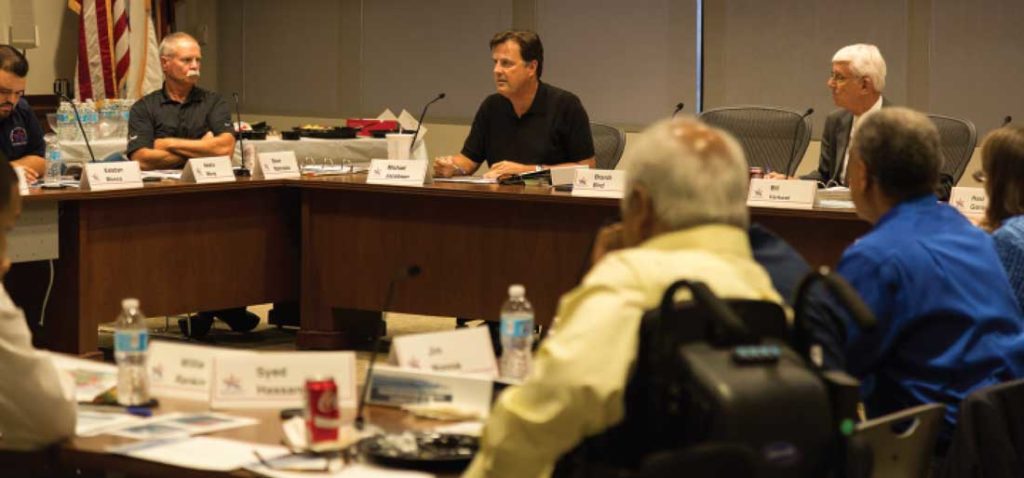
Not All Fun and Games
With sporting events, top-notch entertainment venues, and a booming tourism industry that, according to Williams, brings 15 million people to the city every year, it’s easy to focus on the good life. But there are other things –– and other people –– to consider where public transportation is concerned. For instance, mass transit improves air quality and can lead to improved health. And there are people who need to be able to get to jobs much more than they need to get to a ball game.
Transportation Advisory Committee member Syed Hassan, an economist who lists three master’s degrees on his resume, is most concerned about those who need public transportation if they are going to be able to support themselves and their families.
“Not everybody can afford to have a new car, and sometimes, they cannot afford insurance,” he said.
Hassan, who must rely on a wheelchair, said he is “blessed” to have a van and a job that allows him to support himself. A senior data scientist for GameStop, Hassan believes that many people who are on welfare would prefer to work but do not have a way to get to and from a job.
According to 2010 U.S. Census figures pertaining to Arlington, about 16 percent of families in general and 31 percent of households headed by a female live below the poverty line. Among the population as a whole, about 20 percent live in poverty.
Ahoura Zandiatashbar, a UTA student who is working in the C-TEDD, shares Hassan’s view that mass transit could greatly improve quality of life for those who cannot afford a vehicle. Like Hamidi, Zandiatashbar moved to Arlington from a city where he had lived car-free and relied on public transportation. Bus rides in Troy, N.Y., he said, were free for university students.
Also like Hamidi, Zandiatashbar had hoped to continue living car-free when he moved to Arlington in 2014 to pursue a doctorate in urban planning. Not long after arriving, though, he realized that he could not move around the city without personal transportation. He bought a dark beige 2008 Honda Civic from a friend.
“Arlington is a university town,” Zandiatashbar said. “Mass transit is really, really needed.”
Zandiatashbar feels that if the city doesn’t get moving on public transportation, high-tech corporations, which are increasingly locating to the Fort Worth-Dallas area, will pass Arlington by. If mass transit comes, though, so will those companies –– and they will have a pool of talent right at their doorstep in the form of UTA graduates.
“To me, mass transit is a tool for economic development,” he said.
Hassan feels that city officials would be wise to consider the “opportunity cost,” or the lost potential, of not providing public transportation.
“I would push them to look into opportunity cost, not just the operational cost,” he said. “A lot of [committee members] were business people, and they looked at the operating cost. I’m an economist, and I was looking at the economic cost and benefit of providing that service.”
Hassan said that “so much money” is spent on infrastructure, such as highways, roads, and bridges, and many of the vehicles that travel along them are in “marginal shape.” He feels that there need to be transportation options that will remove some of those vehicles from the roadways.
Mayor Williams said that last year the city made a “record number” of street improvements. In addition to work done on city streets, more than $500 million worth of highway construction is in the works, he said, such as the Highway 360 extension and the Highway 360/I-30 interchange.
Based on studies that have been done in other cities that have mass transit, Hamidi believes that if Arlington follows suit, there will be better air quality due to lower emissions and better health for users because they will be walking more.
Mass transit will “make people more physically active,” she said. “It reduces the chances of obesity and chronic disease, like heart disease, which is connected to being less physically active. If you have to walk to a transit station, you have to be more physically active. There are a lot of health benefits –– so it’s not just about tourism.”
Putting the Wheels in Motion
With the work of the Transportation Advisory Committee drawing to a close (its final meeting before its upcoming presentation to the council was last week, on Sept. 7), Hassan is left with a mild sense of disappointment. The scale of the “final outcome,” he said, is much smaller than he expected. He is unimpressed with options such as Milo, Uber, and Lyft.
“That’s not public transportation,” the economist said. “That’s putting more cars on the road. But that’s the direction [the committee is] going.”
Although some have viewed the committee and its work with excitement, public transportation won’t happen overnight. For now, important questions remain unanswered – questions such as how much it will cost, how it will be funded, when it will go before voters and what, specifically, citizens will vote on.
“You’re jumping to answers I don’t know,” Williams told the Weekly the day before the city debuted Milo. “Everybody’s wanting to have a vote. They always are ready to jump to that. Whenever we have a final plan or something to vote on, we will. But we’re not to that point yet.”
Williams said that after the council hears the transportation committee’s recommendations, town halls will be scheduled for input from citizens. Whatever verbiage ends up being on the ballot, it will be broad enough to allow the City Council to experiment with pilot programs for various types of transportation, some of which may not have been invented yet. As for funding, some transportation options may be “funded privately,” the mayor said.
“In the meantime,” he continued, “we’re continuing to have these pilot projects so citizens can actually see some of this technology, like the vehicles that are driverless. We’ll try them for a while, see if they work, see what our citizens think, and, if they don’t work, we’ll move on to something else. What’s nice is, when you lease it, you’re not tied to it, either.”
Though some have expressed little faith that city leaders will move forward on public transportation initiatives –– perhaps forgetting that it was citizens, not elected officials, who nixed it years ago –– Committee Chair Verkest believes that, well, the wheels are finally in motion.
“The mayor and the council as it exists today are of a mind to do something with regard to public transportation,” he said. “What that is, I can’t answer. We’re going to make recommendations to the mayor and council, and then it’s up to them to decide whether they like what we are recommending or if they would like to do something else.”
Although Hassan had hoped for more meaningful outcomes from the committee, he feels that the creation of the group was “a small babystep in the right direction.
“At least it started the conversation,” he continued. “I think it’s a good start.” l



